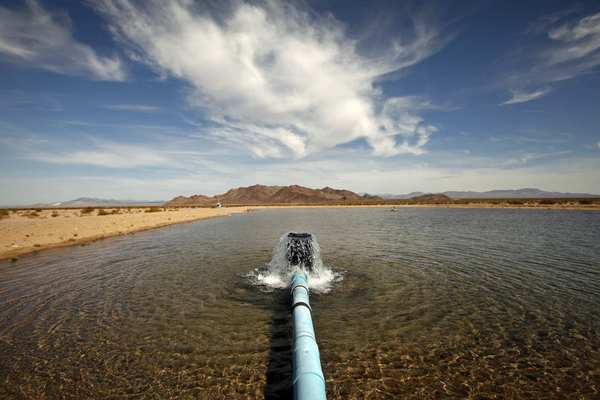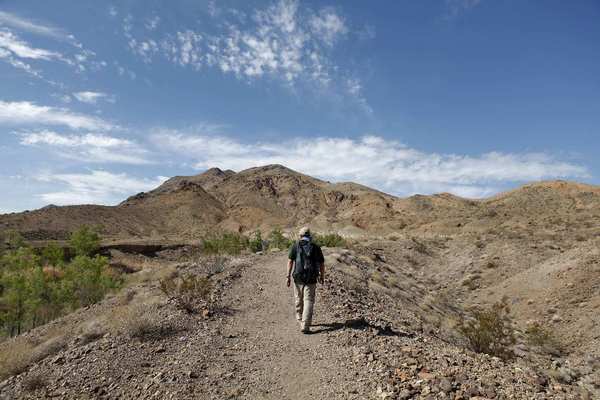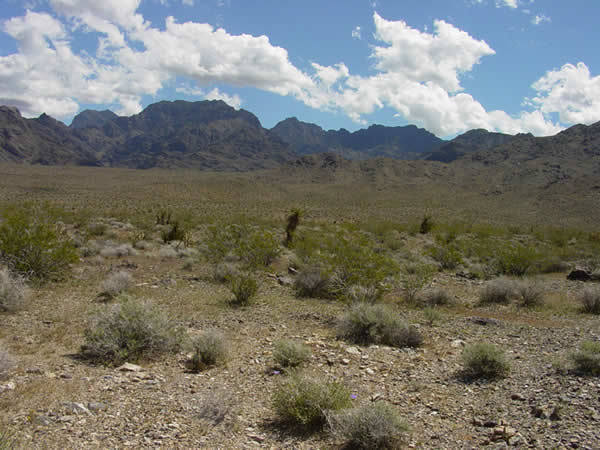Cadiz Inc.’s potentially lucrative groundwater mining proposal for the Mojave Desert intends to water lawns and pools for suburban Southern California at the expense of taxpayers and ultimately the desert ecosystem. The company could realize $1 billion to $2 billion in revenue over the plan’s 50-year life. Opponents say public resources are being used for private profit. The Trump Administration has recently repealed obstacles that make this project very much alive.


Company wants to tap Mojave’s public lands for Southern California water
By Bettina Boxall – Published in the Los Angeles Times
CADIZ, Calif. – Three decades ago a group of businessmen pored over NASA satellite imagery as part of a worldwide hunt for large groundwater reserves they could tap to grow desert crops. They found the signs they were looking for here in the sun-blasted mountain ranges and creosote-freckled valleys of the Mojave Desert, 200 miles east of Los Angeles.
The Bureau of Land Management (BLM) rejected a proposal by the Los Angeles-based company to use a railroad right-of-way across public lands for its 43-mile pipeline to the Colorado River Aqueduct. As a result, Cadiz had to submit a right-of-way application, which required a federal environmental review with public participation. This move did kill the project during the Obama Administration.
Unfortunately, in a 2017 memo, an acting assistant director at Trump’s BLM revoked these two legal guidances that underpinned the agency’s 2015 decision, thus making this destructive project a very real possibility. CA Senator Dianne Feinstein said, “The Trump administration has once again put corporate profits ahead of the public’s interest.”
The group, which founded Cadiz Inc., bought old railroad land, drilled wells and planted neat grids of citrus trees and grapevines, irrigating them with water that bubbled out of the desert depths at the rate of 2,000 gallons a minute.
But by the mid-1990s, Cadiz had a new business plan: Sell water, not lemons. The company is pushing ahead with a proposal to pump enough groundwater every year to supply 100,000 homes and sell it to urban Southern California at prices that could, over the project’s 50-year life, reap $1 billion to $2 billion in revenue. If the plan succeeds, it will turn ancient desert groundwater, a public resource, into a fountain of private profit, blazing a new — and some warn ominous — path in the state.
From Emily Green in Chance of Rain: “What they are actually proposing is sinking deep wells to pump something called the carbonate aquifer rather than more shallow alluvium in a way that the impacts of groundwater mining on the surface would be slower to register for local monitors, that would be potentially more far wide-ranging, unpredictable and irreversible once detectable.”
“I think we’re setting a precedent here for the development of groundwater in the Mojave Desert,” said hydrologist John Bredehoeft, a former regional manager for the U.S. Geological Survey who was hired by conservation groups to review the project.
Public Resource, Private Gain To Serve California’s Growth Addiction
Critics question whether the Southland, infamous for slaking its thirst with water from the Owens Valley and elsewhere, should now draw new supplies from pristine desert watersheds. “It’s taking a public resource that originates on public land, privatizing it and selling it back to the public,” said Seth Shteir of the National Parks Conservation Assn., one of a dozen environmental groups challenging the project. “This water is going to Orange County lawns and swimming pools. The desert is being asked to shoulder the burden.”
Keith Brackpool, the corporation’s politically connected, British-born chief executive, has spent the last 15 years trying to get into the water business. He came close in 2002, nearly sealing a pact with the Metropolitan Water District of Southern California, the region’s giant water wholesaler. The company has made enough progress with its latest proposal to worry long-standing opponents, including Sen. Dianne Feinstein (D-Calif.), who on Friday called for a federal review of the project. Cadiz has lined up new customers, released a thick pile of environmental documents and hired one of the West’s most powerful law firms.
At times sounding like they are describing a major oil discovery, Cadiz officials are pitching the project as a dependable alternative to water deliveries from Northern California and the Colorado River that have been squeezed by drought and environmental regulations. “It is more reliable than anything out there,” said Cadiz President and General Counsel Scott Slater, a partner in the Denver-based law firm of Brownstein Hyatt Farber Schreck, which runs one of the top-grossing lobbying operations in Washington. “The environmental effects are nominal.” A veteran water attorney, Slater is the project’s chief spokesman. Brackpool, chairman of the California Horse Racing Board and a past contributor to high-profile Democrats, has stayed in the background. Thirty years ago he was fined by a British court for dealing in securities without a license.
httpvh://youtu.be/ppGd-2nEOVQ
Chinatown, a film by Roman Polanski, written by Robert Towne, based in part on real events that formed the California Water Wars, in which William Mulholland acted on behalf of Los Angeles interests to secure water rights in the Owens Valley.
Federal lands surround the 34,000 acres the company owns just south of Route 66 near the old railroad stop of Cadiz. A half-dozen congressionally designated wilderness areas are close by. About 15 miles to the north lies the 1.6-million-acre Mojave National Preserve, managed by the National Park Service.
From Emily Green in Chance of Rain on Cadiz’s 2002 proposal: “Among problems noted by federal agencies called in by Metropolitan to review the plan were that US Geological Survey testing showed high levels of ambient Chromium VI — the carcinogen made famous by Erin Brockovich — in Mojave groundwater. How much of this is due to dumping by gas compressor plants and how much is down to the particular chemistry of remarkably sandy soil conditions is unknown. Then there was the likelihood that soil dried out by pumping could produce dust storms. Big-horned sheep and desert tortoises could be left without all-important desert springs. A strict monitoring plan designed in cooperation with federal hydrologists to prevent over-drafting made tapping Cadiz Inc’s miracle-ocean-under-the-desert such a risky investment that in 2002, Metropolitan dropped out.”
Cadiz’s new proposal is overseen by the Santa Margarita Water District, from suburban Orange County California, tasked with providing water for 14,000 new homes approved for Rancho Mission Viejo, as well as replacing rapidly disappearing resources.
Cadiz’s proposed network of 30 wells, each about 1,000 feet deep, would pump groundwater that flows from beneath these public lands and is replenished by rain and snowmelt from their mountain ranges: the Providence and New York, the Marble and the Clipper. The aquifer dates from wetter times long ago, when water seeped into subterranean layers of sand and gravel and deep, ancient formations of limestone and dolomite. Cadiz believes there is enough groundwater to fill California’s largest reservoir roughly four to seven times over.


Siphoning the Mojave Desert’s Last Trickle of Life?
Despite Slater’s assurances, the plan involves a calculated risk to the desert. About 11 miles from the Cadiz lemon groves, on the south side of the Clipper Mountains, is Bonanza Spring. It is the closest to the proposed well field of more than two dozen springs in the area. Bighorn sheep, bobcats and other wildlife come here to lap from the shallow pools of water amid reeds and willow trees, a shock of green in the Mojave’s brown palette.
Experts hired by Cadiz say they are confident the pumping would not hurt Bonanza and the other springs because they are at higher elevations and get their water before it drains into the valley aquifers. “There’s no way we could affect springs up there,” said Terry Foreman, senior hydrogeologist and vice president of CH2M HILL, nodding toward the mountains.
Federal scientists say Cadiz has yet to prove the springs have no connection to the aquifers. “It may be true and it might not be true,” said Debra Hughson, science advisor for the Mojave preserve. Regardless, she called the project an “unsustainable groundwater mining proposal.” Cadiz intends to withdraw more water every year than nature puts back in the ground, lowering the groundwater table and depleting the aquifer. By how much, and whether that will harm the fragile desert environment of nearby public lands, remain important questions.
No one really knows the rate of natural groundwater replenishment in the 1,300-square-mile area that drains toward the Cadiz operation. Scientists can only estimate it based largely on conceptual modeling that has yielded a wide range of numbers over the years. Federal hydrologists and scientists hired by environmental groups say the natural recharge rate is at most half — and could be less than a sixth — of what Cadiz’s experts say it is.
Acknowledging the dispute, the project’s draft environmental report, released in December, concludes that a half century of pumping would deplete native groundwater reserves by a minimum of 3% and possibly as much as 13%, depending on natural replenishment rates and the size of the aquifer. Nearly four centuries would have to pass before aquifer storage fully recovered from the larger decline.
Financing from Public Agencies
Financing is another looming question. The project has a preliminary price tag of $225 million to $275 million. According to the company’s latest annual report, Cadiz, which is publicly traded, is losing money on its operations and has a debt of $56.6 million. It has so far struck option agreements to sell up to 80% of the groundwater to three investor-owned utilities and three public water districts that serve portions of Southern California, including the second largest in Orange County, Santa Margarita.
From Emily Green in Chance of Rain: “The Cadiz self-styled “dry year supply project” is best known as a synonym for cronyism,” having once employed former Governor Schwarzenegger’s Chief of Staff, Los Angeles Mayor Antonio Villaraigosa, and former Secretary of the Interior Bruce Babbitt.
To price the supplies competitively, Cadiz is hoping for public subsidies. Those include credits from the Metropolitan Water District, state and federal grants and public financing of some or all of the capital costs of the project’s most expensive component, a 43-mile pipeline that would transport water from the well field to the Colorado River Aqueduct.
Without subsidies, the options show that Cadiz water would be among the most expensive in the Southland, nearly $1,100 an acre-foot for untreated supplies. Treatment would further jack up the price. Metropolitan plans to next year charge $847 an acre-foot for treated supplies. John Schatz, general manager of the Santa Margarita district, which has signed up for the biggest share of Cadiz water and is leading the project’s environmental review process, said the price is high but Metropolitan rates are rising and the groundwater’s reliability adds to its value.
Debbie Cook, former Mayor of Huntington Beach, was quoted in the Orange County Register saying the new project is “worse” than the rejected 2002 proposal, which would have diverted water from the Colorado River for storage in the Cadiz aquifer. “This one is only about removing water,” Cook said. “To me it’s just mind-boggling anyone would propose something like this. It’s like pulling money out of the bank and never putting any money in. It’s like eating your seed corn.”
Under the proposal, Santa Margarita and other customers would form a private mutual water company that would buy supplies from Cadiz and manage the operation. Mutual water companies are not regulated by the California Public Utilities Commission and members would be free to sell their water. “We certainly contemplated that in the overall approach,” Schatz said.
Nor is groundwater use regulated by the state. San Bernardino County supervisors — who have received $79,500 combined in campaign contributions from Cadiz since 2007 — recently voted to give Cadiz an exemption from the county’s desert groundwater ordinance, instead approving an agreement that gives the county authority to enforce the project’s monitoring and management plan.


Federal Oversight?
Missing from the oversight lineup are the federal agencies that manage nearby land. Cadiz argues that it does not need federal approval because its pipeline route follows an existing railroad right-of-way. But a recent Interior Department solicitor’s opinion held that railroads cannot authorize activities in their federal right-of-ways “that bear no relationship to the construction or operation of a railroad.”
In a recent letter to Interior Secretary Ken Salazar, Feinstein dismissed Cadiz’s arguments that the railroad could use the pipeline to put out trestle fires and wash rail cars. “California’s Mojave Desert is a unique and special place … that must be protected,” wrote Feinstein, requesting a full review of the project under federal environmental law.
Updated May 12, 2017









Thank you, Jack, for this article and WilderUtopia. I wish that everyone living in Southern California would visit your site and take cognizance of the issues!
Pingback: Irresponsible OC water district threatening pristine desert watersheds | OC Politics Blog
Pingback: Powerplay: A Plan To Game The CA Coastal Act | WilderUtopia.com
Pingback: EcoJustice Radio – Episode 5 – Preserving the Mojave Desert from Cadiz Water Project | WilderUtopia.com